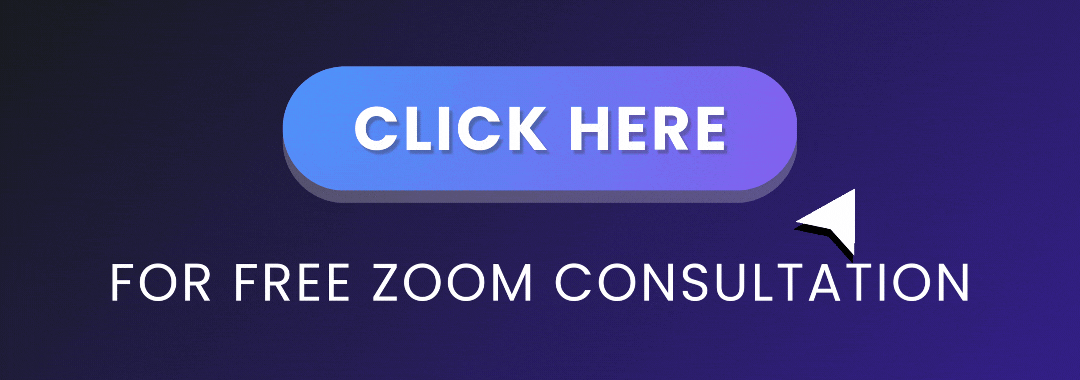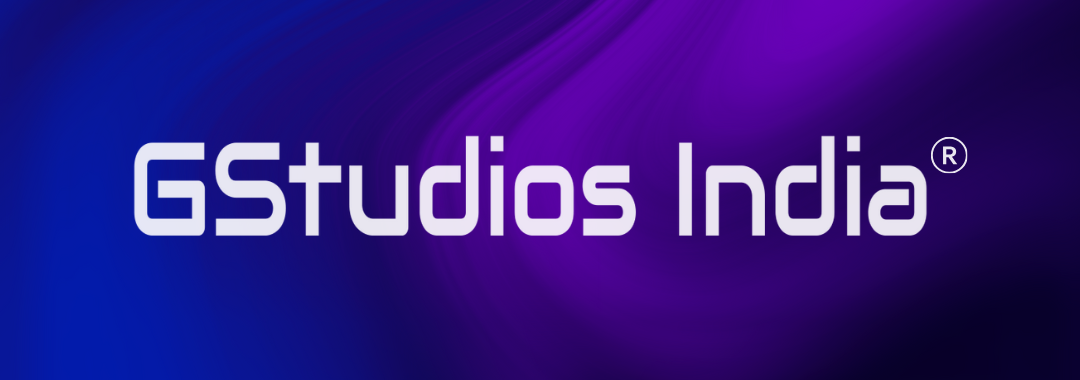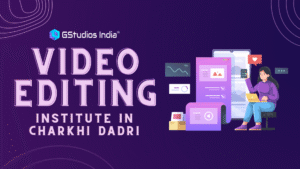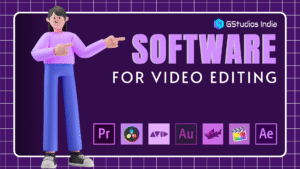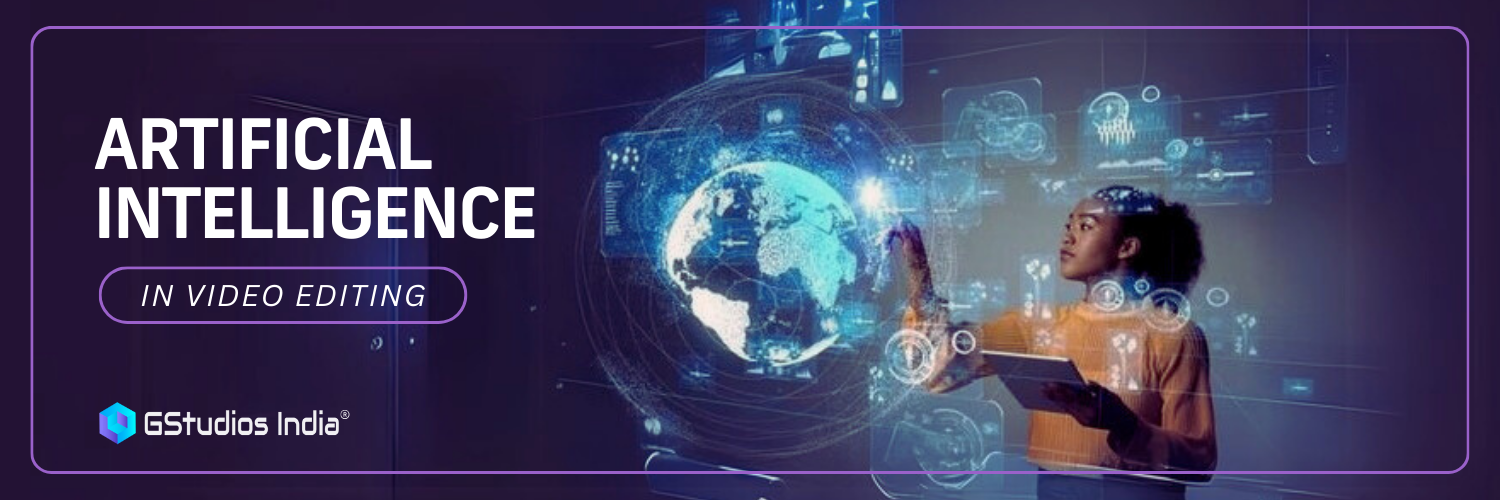
Artificial Intelligence (AI) is revolutionizing various industries, and video editing is no exception. Traditionally, video editors have been the unsung heroes behind the scenes, meticulously crafting raw footage into compelling narratives.
However, with the advent of AI, the landscape of video editing is undergoing a significant transformation. This shift raises an intriguing question: How will video editors evolve to exert greater creative control over storytelling?
In this blog, we’ll explore how AI is reshaping the role of video editors, the transition from manual editing to AI-assisted storytelling, real-world applications of AI in video production, the new skill sets required for future editors, and the potential for editors to become creative directors.
⚡How AI is Changing the Traditional Role of Video Editors
Video editing has always been a demanding and intricate process. Editors must sift through hours of raw footage, selecting the best takes, arranging scenes logically and engagingly, and refining the final product through techniques such as color correction, sound design, and visual effects. This meticulous work requires both technical expertise and a deep understanding of storytelling principles to ensure the final content resonates with the audience.
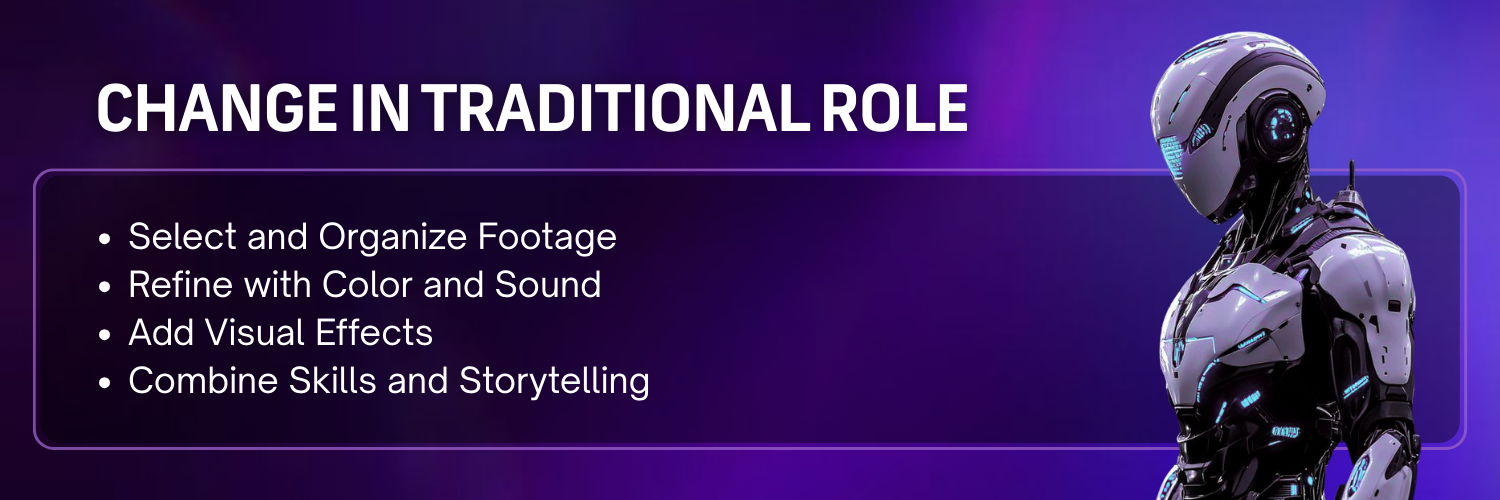
However, the rise of Artificial Intelligence (AI) is dramatically transforming this traditional workflow. AI-powered tools can now automate repetitive tasks, analyze vast amounts of video data, and even make creative decisions. This shift is not solely about increasing efficiency; it is redefining the very role of video editors in the production process.
🤖 Key AI Functions in Video Editing
AI is revolutionizing video editing by automating tasks that previously required hours of manual effort. Some of the most impactful AI-powered features include:

- Automated Cutting & Scene Selection
- AI can analyze raw footage, detect essential moments, and trim unnecessary sections.
- It recognizes patterns, movements, and facial expressions, making initial cut suggestions that align with the intended narrative.
- This significantly reduces the time editors spend manually reviewing footage.
- Scene Detection & Organization
- AI can categorize footage based on elements like characters, objects, or background settings.
- Editors can easily search for specific shots or scenes, speeding up the post-production process.
- Machine learning algorithms help in structuring a sequence logically and compellingly.
- Color Correction & Grading
- AI-driven tools analyze lighting conditions and color schemes to ensure consistency across scenes.
- Auto-adjustments can match different clips, maintaining visual harmony throughout the video.
- Some AI applications can even replicate specific cinematic styles or moods based on references.
- Audio Enhancement & Noise Reduction
- AI can eliminate background noise, balance audio levels, and enhance speech clarity.
- Some tools even provide automatic voice synchronization, ensuring perfect lip-sync in dubbed content.
- Music and sound effects can be automatically adjusted to match the mood and pacing of a scene.
- AI-Powered Motion Tracking & Visual Effects
- AI enables automatic object tracking, making tasks like applying effects, blurring objects, or stabilizing shaky footage seamlessly.
- It simplifies complex visual effects, allowing editors to integrate CGI elements without needing extensive manual adjustments.
🎥 The Shift from Technical Execution to Creative Storytelling
As AI assumes control of repetitive and technical tasks, video editors have more time to concentrate on storytelling, pacing, and creative direction. Instead of spending hours adjusting color correction or manually cutting scenes, editors can:

- Experiment with new storytelling techniques, testing different versions of edits to see what resonates best.
- Explore AI-generated suggestions, which can introduce unique perspectives they may not have considered manually.
- Collaborate more effectively with directors and cinematographers, ensuring the vision of the project is realized.
This shift not only streamlines the editing process but also empowers editors to experiment with new ideas and techniques, expanding their creative roles within the production pipeline. As AI continues to evolve, editors may find themselves moving beyond their traditional roles, potentially stepping into the realm of creative directors, shaping the overall vision of a project rather than just assembling footage.
🕒 The Shift from Manual Editing to AI-Assisted Storytelling
The transition from manual video editing to AI-assisted storytelling is similar to moving from typewriters to computers. The core principles of storytelling remain the same, but the tools have advanced to make the process faster, smoother, and more creative. Artificial Intelligence (AI) is not replacing human creativity; instead, it is helping editors work more efficiently by automating repetitive tasks.

Let’s explore how traditional editing differs from AI-assisted editing and how these advancements are transforming the role of video editors.
💡Traditional Manual Editing
Before AI, video editing was a labor-intensive process that required:

- Manually Reviewing Footage: Editors had to watch hours of raw video to find the best clips.
- Making Cut Decisions: Deciding which parts of a video to keep or remove based on the story.
- Applying Effects and Transitions: Manually adding visual effects, sound enhancements, and smooth scene transitions.
- Color Correction and Audio Adjustments: Editing the color tones for consistency and balancing sound levels to improve clarity.
Since editors had to handle everything manually, the process took a lot of time and effort. Often, editors worked long hours to meet tight deadlines, leaving less time for creative storytelling and experimentation.
🖥️ AI-Assisted Editing: How It Works
AI-powered video editing tools use smart algorithms to analyze video content, recognize patterns, and even make automatic editing decisions. These tools help editors by handling time-consuming tasks so they can focus more on storytelling.

Here’s how AI is making a difference:
1. Automated Scene Detection and Organization
AI can automatically detect different scenes and objects in a video. This helps editors:
- Identify Key Scenes Faster: AI recognizes changes in lighting, location, and movement to divide footage into scenes.
- Organize Footage Efficiently: Instead of manually sorting through clips, AI can categorize footage based on faces, objects, or themes.
- Reduce Editing Time: Editors don’t have to watch hours of raw footage—they can simply search for specific shots.
2. Smart Editing Suggestions
AI can learn from editing patterns used in professional films and suggest improvements. For example:
- Automated Cutting: AI removes unnecessary pauses, silences, or shaky footage to make the video flow smoothly.
- Pre-set Editing Styles: Some AI tools analyze a video’s mood and suggest effects, transitions, and background music to match.
- AI-Powered Storytelling: AI can suggest different scene arrangements to create a stronger emotional impact.
3. AI-Powered Color Correction and Audio Enhancement
Fixing color tones and sound quality can take hours, but AI simplifies this process:
- Color Matching: AI analyzes different clips and ensures consistent lighting and color grading throughout the video.
- Noise Reduction: Background noises, like wind or static, can be automatically removed to improve sound clarity.
- Voice Enhancement: AI can adjust dialogue volume so voices are clear and balanced with background music.
4. Transcription and Subtitle Generation
AI can convert spoken words into text instantly. This is helpful for:
- Editing Interviews and Documentaries: Editors can search for keywords in the transcript to find important clips.
- Adding Subtitles Automatically: AI generates accurate subtitles, making videos more accessible to audiences.
✨How AI Helps Editors Focus on Storytelling
Since AI handles many technical tasks, editors can now spend more time on the creative aspects of storytelling, such as:

- Choosing the Best Shots for Emotional Impact
- Experimenting with Different Scene Sequences
- Adding Unique Effects and Styles to Videos
- Creating More Engaging and Personalized Content
Rather than merely functioning as technical operators, editors can embrace a more creative role akin to that of a director, shaping the entire visual narrative.
💡Case Studies of AI-Powered Video Production in Filmmaking and Social Media
AI is making a huge impact on video production, not just in Hollywood but also in social media, marketing, and even corporate training. Advanced AI tools are now capable of generating, editing, and enhancing videos with minimal human input, making content creation faster, cheaper, and more accessible.

Let’s take a closer look at some of the most powerful AI-driven video tools shaping the industry today.
1. OpenAI’s Sora: Revolutionizing AI-Generated Videos
One of the most talked-about AI video tools is Sora, developed by OpenAI. Sora can generate highly realistic video scenes from simple text prompts. This means that instead of using a camera, lights, and actors, a filmmaker can type a description, and AI will create a video based on it.
Key Features:
- Text-to-Video Generation: Just type a description, and Sora will create a video based on the prompt.
- Realistic Environments and Characters: The AI generates lifelike scenes, though it still struggles with complex movements like hand gestures.
- Potential Use in Movies & Ads: While still in development, Sora could reduce costs for big-budget productions by replacing traditional set-building.
Currently, Sora is available only to ChatGPT subscription holders, but it signals a massive shift in the film, TV, and advertising industries.
2. Runway’s Gen-2: AI-Powered Text-to-Video Creation
Another groundbreaking AI tool is Runway’s Gen-2, which allows creators to generate videos from text descriptions, images, or even short video clips. Unlike traditional video editing, where users manually cut and arrange footage, Gen-2 can create brand-new content from scratch.
Key Features:
- Multimodal AI System: It can generate videos from text, images, or existing clips.
- Easy Storyboarding: Filmmakers can create concept videos without shooting real footage.
- Creative Experimentation: Artists and designers can explore unique visuals without expensive software or production teams.
This tool is one of the first commercially available text-to-video models, making high-quality AI-generated videos accessible to independent creators.
3. Synthesia: AI-Driven Corporate Video Production
Synthesia is an AI-powered platform designed for businesses looking to create professional videos without hiring actors, studios, or voice-over artists. With AI-generated avatars, companies can create training videos, presentations, and marketing content simply by entering text.
Key Features:
- AI-Generated Presenters: Choose from a variety of virtual avatars that can read your script in multiple languages.
- Text-to-Video in Minutes: No need for filming—just type your content, and Synthesia will generate a professional-looking video.
- Perfect for Businesses: Ideal for corporate training, online courses, and company announcements.
This tool is widely used by corporations and educational institutions to create content without the need for expensive video production teams.
4. Lightricks’ Videoleap: AI for Mobile Video Editing
For content creators who edit videos on their phones, Videoleap by Lightricks offers a powerful AI-assisted editing experience. This app is designed for social media users, helping them create high-quality, engaging videos quickly.
Key Features:
- AI-Powered Special Effects: Add cinematic transitions, text animations, and visual effects with a single tap.
- Automatic Background Removal: No green screen needed—AI can isolate subjects and replace backgrounds instantly.
- Easy-to-Use for Beginners: A simple drag-and-drop interface makes video editing accessible to anyone, even those without experience.
With Videoleap, users can create Instagram Reels, YouTube Shorts, and TikTok videos in minutes, making it one of the best AI tools for influencers and social media creators.
5. Pictory: AI for Automated Video Summaries
Pictory is a unique AI tool that helps convert long-form content into short, engaging videos. It’s particularly useful for content creators, marketers, and educators who want to repurpose their existing material.
Key Features:
- Turns Blogs & Articles into Videos: AI scans written content and converts it into video summaries with visuals and voiceovers.
- Automatic Captioning: Adds AI-generated subtitles to improve accessibility.
- Great for YouTube & Social Media: Perfect for repurposing podcasts, webinars, and written content into video format.
Pictory is widely used by businesses and educators who need to create informative and engaging content without manual editing.
6. Descript: AI for Podcast & Video Editing
Descript is an AI-powered editing tool that’s especially popular for podcasts and video interviews. Instead of manually cutting and editing, Descript transcribes audio into text, allowing users to edit their videos like a document.
Key Features:
- Text-Based Editing: Simply delete words from the transcript, and the AI removes the corresponding audio/video.
- AI Voice Cloning: If you make a mistake, Descript can generate your voice to fix errors without re-recording.
- Screen Recording & Video Templates: Helps streamline content creation for YouTubers and educators.
This tool is game-changing for content creators who want fast, efficient, and high-quality video editing.
AI-powered video tools like Sora, Runway Gen-2, Synthesia, Videoleap, Pictory, and Descript are revolutionizing how videos are made. Whether for big-budget filmmaking, corporate presentations, or social media content, AI is making video production faster, cheaper, and more accessible.
While AI can automate many tasks, it still relies on human creativity. The best videos are made by combining AI’s efficiency with human storytelling skills. As AI continues to improve, video editors may evolve into creative directors, using AI as a powerful tool to bring their visions to life.
🌟 The Evolving Skills Needed for Future Video Editors
As AI continues to reshape video editing, the skills required for editors are also evolving. While traditional editing skills like cutting, color correction, and sound design remain important, new competencies are becoming essential to stay relevant in the industry.
Future video editors will need to balance creativity with technology, understanding how to collaborate with AI tools while still bringing their unique artistic vision to life. Let’s explore the key skills that will be crucial for the next generation of video editors.

1. Technical Proficiency with AI Tools
AI-powered video editing software is becoming more advanced, and editors must learn how to use these tools effectively. Instead of replacing editors, AI is designed to assist them, automating repetitive tasks and enhancing creativity.
Why It’s Important:
- AI can automatically cut clips, enhance colors, remove noise, and add effects, saving time.
- Knowing how to use AI tools helps editors work faster and more efficiently.
- Editors who understand AI stay ahead of the competition in the job market.
Tools to Learn:
- Adobe Premiere Pro & After Effects (with AI features)
- Runway ML – AI-assisted video editing and text-to-video generation
- Descript – Text-based video editing for podcasts and interviews
- Synthesia – AI avatar-based video creation
The key is to master these AI tools without relying on them completely—human creativity is still essential!
2. Data Analysis and Interpretation
AI tools don’t just help with editing—they also provide valuable data on how audiences engage with videos. Future editors need to understand how to analyze and use this data to create more effective and engaging content.
Why It’s Important:
- AI can track which scenes keep viewers engaged and which parts they skip.
- Editors may use this data to refine pacing, structure, and storytelling techniques.
- Understanding audience preferences helps editors create content that performs better on platforms like YouTube, TikTok, and Instagram.
What to Focus On:
- Watch Time & Drop-off Rates – When do viewers stop watching?
- Engagement Metrics – Likes, comments, and shares indicate audience interest.
- A/B Testing – Comparing different edits to see what works best.
Future editors won’t just be cutting videos—they’ll be strategically shaping content based on audience insights.
3. Creative Direction and Storytelling
As AI takes over technical tasks, editors will have more time to focus on creativity. This means they’ll need to develop stronger storytelling skills, taking on roles similar to creative directors.
Why It’s Important:
- A compelling story captivates audiences; even the most advanced AI tools cannot replicate human emotion and storytelling.
- Editors must decide how to arrange scenes, build tension, and evoke emotions.
- Creative direction goes beyond editing—it involves understanding cinematography, sound design, and visual aesthetics.
How to Improve Storytelling Skills:
- Study film editing techniques used in movies and TV.
- Learn about pacing, transitions, and visual storytelling.
- Experiment with different styles and moods in video editing.
In the future, editors won’t just edit videos—they’ll be crafting compelling visual stories.
4. Adaptability and Continuous Learning
Technology is advancing faster than ever, and video editors must stay updated with the latest trends, software, and AI capabilities. Being open to learning new skills and tools will be key to long-term success.
Why It’s Important:
- New AI tools are constantly being developed—editors must adapt quickly.
- Trends in video content change rapidly (e.g., short-form videos, immersive experiences).
- The best editors are always experimenting with new techniques and staying ahead of industry shifts.
How to Stay Updated:
- Follow video editing communities on YouTube, Twitter, and LinkedIn.
- Take online courses on platforms like Skillshare, Udemy, and Coursera.
- Stay informed about new AI editing tools and software updates.
Adaptability is key—editors who embrace change will thrive in the evolving world of video production.
AI is not replacing video editors—it’s transforming their role. Future editors will need to combine technical expertise with storytelling skills, using AI as a tool to enhance their creativity rather than replace it.
- The editors of tomorrow will be:
Tech-savvy – Mastering AI-powered editing tools. - Data-driven – Understanding audience engagement and analytics.
- Creative storytellers – Focusing on emotional impact and storytelling.
- Lifelong learners – Continuously updating their skills to stay ahead.
By adapting to these changes, video editors will not only stay relevant but also expand their creative possibilities, taking on roles closer to that of creative directors.
🎯Conclusion
AI is not replacing video editors—it is transforming their roles. Instead of focusing solely on technical tasks, editors now have the opportunity to take on more creative responsibilities. AI-powered tools allow them to experiment with storytelling, improve audience engagement, and shape the overall vision of a project. This shift makes video editing more dynamic and opens up new career possibilities.
As AI continues to evolve, editors who embrace these advancements will have a competitive edge. Learning to use AI tools, analyzing audience data, and refining storytelling skills will be essential for success. Those who adapt will not only enhance their editing abilities but also step into leadership roles in creative direction and content strategy.
The future of video editing is a blend of technology and creativity. AI may handle repetitive tasks, but human intuition, storytelling, and artistic vision will always be irreplaceable. By combining AI efficiency with human creativity, editors can produce more engaging, impactful content and redefine their roles in the filmmaking and content creation industries. When used wisely, AI can elevate the creative process to new heights.
🌟 Enhance your understanding of AI and video editing!
Enroll in our courses—limited seats available! Book your FREE CONSULTATION today.
Authored by : Forum Shah || Graphics by : Maansi Jain

